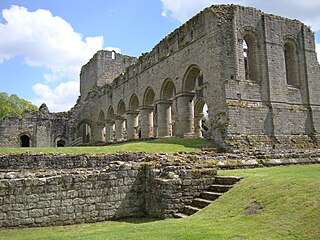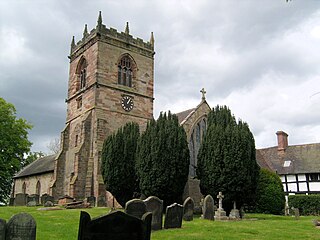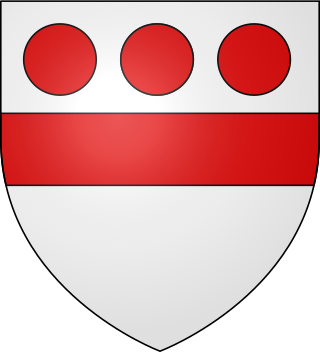Related Research Articles

Godfrey Giffard was Chancellor of the Exchequer of England, Lord Chancellor of England and Bishop of Worcester.
Sir Bertram de Criol was a senior and trusted Steward and diplomat to King Henry III. He served as Constable and Keeper of Dover Castle, Keeper of the Coast and of the Cinque Ports, Keeper of the receipts, expenses and wardships of the archbishopric of Canterbury, Constable of the Tower of London and Sheriff of Kent.
Walter Giffard was Lord Chancellor of England and Archbishop of York.

Nicholas de Crioll, of a family seated in Kent, was Constable of Dover Castle and Keeper of the Coast during the early 1260s. His kinsman Bertram de Criol had distinguished himself in these offices during the preceding 20 years and both were near predecessors of the eminent Warden of the Cinque Ports, Stephen de Pencester.

Buildwas Abbey was a Cistercian monastery located on the banks of the River Severn, at Buildwas in Shropshire, England - today about 2 miles (3.2 km) west of Ironbridge. Founded by the local bishop in 1135, it was sparsely endowed at the outset but enjoyed several periods of growth and increasing wealth: notably under Abbot Ranulf in the second half of the 12th century and again from the mid-13th century, when large numbers of acquisitions were made from the local landed gentry. Abbots were regularly used as agents by Plantagenet in their attempts to subdue Ireland and Wales and the abbey acquired a daughter house in each country.

The Barony of Kendal is a subdivision of the English historic county of Westmorland. It evolved from one of two ancient baronies that make up the county, the other being the Barony of Westmorland. In 1974, the entire county became part of the modern county of Cumbria and ceased to have an administrative function. At the same time, Kendal borough along with some other rural and urban districts in Westmorland was merged with the neighbouring parts of Lancashire, Furness and Cartmel, and also the Sedbergh Rural District of the West Riding of Yorkshire into the new South Lakeland district of the new county.

St Peter's Collegiate Church is located in central Wolverhampton, England. For many centuries it was a chapel royal and from 1480 a royal peculiar, independent of the Diocese of Lichfield and even the Province of Canterbury. The collegiate church was central to the development of the town of Wolverhampton, much of which belonged to its dean. Until the 18th century, it was the only church in Wolverhampton and the control of the college extended far into the surrounding area, with dependent chapels in several towns and villages of southern Staffordshire.
The Close Rolls are an administrative record created in medieval England, Wales, Ireland and the Channel Islands by the royal chancery, in order to preserve a central record of all letters close issued by the chancery in the name of the Crown.

Lapley Priory was a priory in Staffordshire, England. Founded at the very end of the Anglo-Saxon period, it was an alien priory, a satellite house of the Benedictine Abbey of Saint-Remi or Saint-Rémy at Reims in Northern France. After great fluctuations in fortune, resulting from changing relations between the rulers of England and France, it was finally dissolved in 1415 and its assets transferred to the collegiate church at Tong, Shropshire.
Ralph de Brantingham was an English noble of the mid-fourteenth century, who served as King's Chamberlain to Edward III.

Black Ladies Priory was a house of Benedictine nuns, located about 4 km west of Brewood in Staffordshire, on the northern edge of the hamlet of Kiddemore Green. Founded in the mid-12th century, it was a small, often struggling, house. It was dissolved in 1538, and a large house was built on the site in Tudor and Jacobean styles by the Giffard family of Chillington Hall. Much of this is incorporated in the present Black Ladies, a large, Grade II*-listed, private residence.
John de Echingham S.T.D. was an English medieval Chancellor of the University of Oxford, who held that dignity for three consecutive years.
William Cosyn was priest, a JP for Somerset from 1506–1516, and Dean of Wells Cathedral from 1498–1525.
William Devereux, was an important Marcher Lord, and held Lyonshall Castle controlling a strategically vital approach to the border of Wales. The castle's significance was heightened by the rebellion of Llywelyn ap Gruffudd, Prince of Wales. With strong family ties to the politically powerful families of Cantilupe and Giffard, his support was strongly sought after by Henry III and Simon de Montfort throughout the Second Barons' War.

William Devereux, Baron Devereux of Lyonshall was an English noble who was an important Marcher Lord as he held Lyonshall Castle controlling a strategically vital approach to the border of Wales in the time of Edward I and Edward II. He was the first of this family officially called to Parliament, and was ancestor to John Devereux, 1st Baron Devereux of Whitchurch Maund, the Devereux Earls of Essex, and the Devereux Viscounts of Hereford. His coat of arms was the same as his father's and described as "argent, fess and three roundels in chief gules" which passed to the descendants of his first wife, the Devereux of Bodenham; or "gules od un fesse d'argent ove turteaus d'argent en le chief" which passed to the descendants of his second wife, the Devereux of Frome.

The recorded abbots of Shrewsbury run from c 1087, four years after Shrewsbury Abbey's foundation, to 1540, its dissolution under Thomas Cromwell. The abbey was large and well-endowed and the abbots were often important political figures as well as ecclesiastical leaders. They varied greatly over the centuries in ethnic and social origins, intellectual attainments and holiness of life. The first two, Fulchred and Godfred, were imported from Normandy. The remainder seem to have been born in Britain and most, but not all, were elected, or at least selected, from the chapter of the abbey. As important territorial magnates, the abbots were always called to take part in the sessions of Parliament from its very beginnings as an institution in 1265. As important figures in the Western Catholic Church, abbots were permitted by the Pope to wear the pontifical ring from 1251 and the mitre from 1397.
Guy de Bourgogne, O.Cist., was a French monk, Abbot, and Cardinal of the Roman Catholic Church.
Andrew de Bolingbroke was one of two Members of Parliament for the constituency of York along with John de Askham from 1299 to 1304.
John Hovyngham, also written Honyngham or Ovyngham, was an English clergyman, notary, diplomat and Archdeacon of Durham.
References
- ↑ John F Curwen, ed. (1926). "Records of Kendale: The pre-Reformation rectors and vicars of Kirkby-in-Kendale'". Records Relating To the Barony of Kendale: Volume 3. pp. 35–42.
- ↑ "Historical Papers and Letters from the Northern Registers", Rerum Britannicarum Medii Aevi Scriptores Or, Chronicles and Memorials of Great Britain and Ireland During the Middle Ages, vol. 61, Public Record Office, 1965
- ↑ H C Maxwell Lyte, ed. (1913), "1272, membranes 27, 26, 25, 24, 23, 22, 21, 20, 19, 18, 17", Calendar of Patent Rolls, Henry III: Volume 6, 1266-1272, pp. 614–642